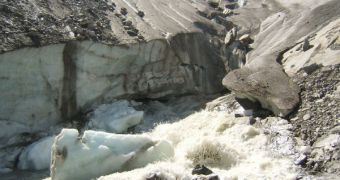Geologists in Kyrgyzstan are currently struggling to get the world's attention on the extremely serious conditions of their country's glaciers. In the best case scenario, the ice spreads that managed to endure the warming of the climate better dropped in levels by about 20 percent over the last 50 years. The worst-off glaciers have disappeared completely, leaving the mountaintops they once occupied completely bare. The situation is growing even worse by the years, the BBC News reports, quoting experts in charge of glacier studies in the central-Asian nation.
According to geologist Bakutbek Ermenbaev, who is an expert at the national hydrogeology agency, global warming is the main factor that led to the excessive melt. He argues that, within a century, all of the country's 2,200 glaciers could disappear, if world leaders do not come to an agreement this year. In December, the city of Copenhagen is scheduled to host the third-in-a-row UN Climate Summit, which aims at deciding upon a successor for the Kyoto Protocol. This year is the last one to sign the new treaty, if governments are to give themselves sufficient time to ratify the treaty by 2011.
The thing about the Kyrgyz glaciers is that they are of paramount importance to water supplies in central Asia, together with other ice spreads in neighboring Tajikistan. Careful and sustainable exploitation is therefore absolutely necessary, so that all the lands being irrigated from rivers spawned by the glaciers do not experience the adverse effects of drought. “In normal circumstances the glaciers would melt in the summer season, but regain their size in the winter,” Ermenbaev reveals, adding that, over the past years, this has not been the case. The amounts of ice depleted in the summer did not grow back in the winter.
“On average, all around the country, we can say the glaciers have decreased in size by about 20%. In the last 20 years this has been happening more rapidly than in the previous years. When a glacier starts melting it creates small lakes, and each year the size of those lakes is growing,” the expert explains. The thing about this trend is that it appears beneficial in the short term. Downstream countries will benefit from more water for their cotton-growing industries, but, within a few decades, the supplies will be completely depleted, leading to massive economic consequences.

 14 DAY TRIAL //
14 DAY TRIAL //